You have several blank walls in your home and you have a collection of mirrors. How do you hang your mirrors for the best effect? What are the recommended sizes and heights? Learn everything you need to know in this comprehensive guide.
Mirror placement is partly a matter of taste but there are important principles: use the rule of quarters to place your mirror 3/4 of the way between the floor and the ceiling. Size your mirror to be 2/3 to 3/4 the width of the furniture below. Most mirrors should be hung at eye level about 5 feet above the ground.
Should I use a single mirror or a gallery of mirrors?
An important choice for interior decorators is whether to use a single, large, show-stopping mirror or go for a collection of smaller mirrors arranged in what is known as a gallery wall.
A single, impressive mirror adds drama and gravitas to the room whereas a gallery of mirrors can tell a story that will generate interest and excitement:

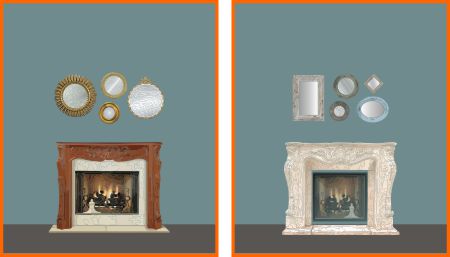
As an Amazon Associate, I earn from qualifying purchases.
If you have a collection of smaller mirrors and would like to make a gallery wall, follow these tips:
How to design your wall gallery of mirrors
Many homeowners have a collection of small mirrors either handed down in the family or perhaps collected from estate sales or antique shops. How do you go about arranging them into a wall gallery?
It is a good idea to vary the shapes and sizes of your mirrors but experienced designers recommend uniting the groups around a theme like the style of the frames – contemporary, traditional, country, southwestern, gilded, or rustic.
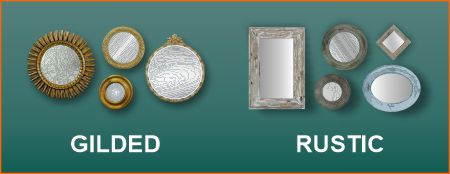
Other themes may be related to the composition of the frames: think Mexican tin, ultra-modern steel, or ornate gesso. Don’t forget that you can increase the excitement by adding a matching print or painting to contrast with the mirrors.
How to design the layout of your mirror gallery.
To experiment with the gallery layout, use paper or cardboard taped to the wall. This will save repairing nail holes placed in error. Remember that when considering height and position – use the gallery outline as your guide.

Now you have decided on your single mirror or your mirror grouping: what are the principles of placement?
Principles of Mirror Placement
The exact position of your mirror will depend on numerous factors including, personal taste, the layout of your room, and the height of your family members. However, there are widely accepted and important rules that will help to guide you:
Rules for mirror width – rectangular mirrors
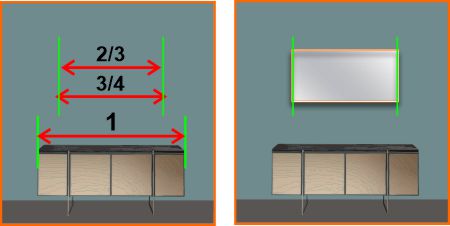
A residential mirror is most often centered above a piece of furniture. This may be a fireplace, a sofa, a credenza, a sideboard, or a table. The recommended width of a rectangular mirror is between 2/3 and 3/4 of the width of the related furniture.
Widths of mirror groups or galleries
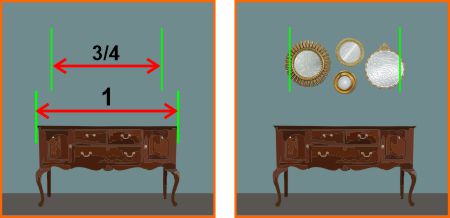
A slightly larger width is pleasing to the eye when your grouping includes “white space” as in the case of the circular mirrors above. Here, somewhat more than 3/4 of the furniture width looks best. Use your judgment.
What are the rules for mirror height?
Use the rule of quarters

In a typical room, with 8 or 9-foot ceilings, the optimal height of a wall mirror can be found by dividing the wall into four quarters. Using this method, the best mirror position is between half and three-quarters of the way up the wall as shown above. This method is a good rule of thumb on most walls except for extremely tall vaulted ceilings where a commonsense approach is better. However, always keep the height of your family members in mind as explained below:
Consider family members: use the five-foot method
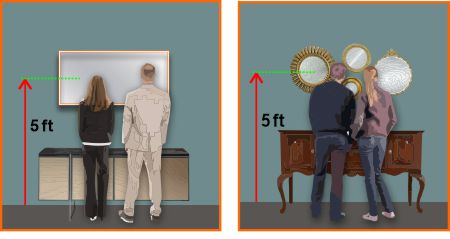
Every family is different but it turns out that 5 feet is a good average distance to the eye level of a typical adult. So use this as an additional guide to mirror placement on your wall, unless you have a house full of basketball players!
Mirrors over fireplaces
A fireplace is the focal point of many traditional living rooms and a mirror over the mantle is a great way to add drama. Remember to always pay attention to the objects that will be reflected – avoid the unpleasant surprise of a less-than-attractive view.

Bold, dramatic single mirrors work best over fireplaces. Use vertical or circular shapes for drama. A rule of thumb is to leave a space of about 5 inches above the mantlepiece to avoid cramping the mirror – and to allow room for accessories.
Wall mirrors between windows
In architecture, the space between large traditional windows is called the “pier”. A stylish pier mirror is a great compliment to this prime location.
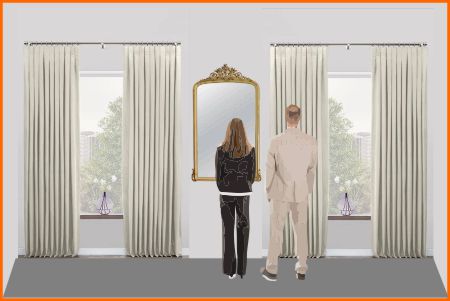
Place the mirror to “fill” the space between the two windows – vertical mirrors nearly always look best. Avoid placing mirrors on the walls opposite large bright windows – sunlight will back-light you making it difficult for you to look into the mirror.
Coordinate your mirror style with your furniture
Remember that a mirror is simply a sheet of glass with a silver coating on the back. Unadorned, it is uninteresting – it is the frame and the position on the wall that defines the mirror’s decorative appeal. Always consider the mirror in the context of the associated furniture:
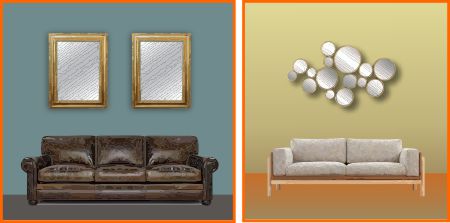
Traditional gilded, beveled mirrors match the traditional leather ottoman (left) while a playful modern arrangement of circular mirrors is ideal for the contemporary sofa (above right). For contemporary mirrors – check out this page from Amazon.
Make a vignette
Tell a story with a collection of objects including mirrors.

An antique rococo-style, gilded mirror highlights a marble-topped Sheraton table to make a vignette complete with brass candlesticks (above left). At above right: shabby-chic reigns supreme as distressed wooden mirror frames coordinate with a rustic sideboard for a country vibe.
Functional mirrors – bathrooms & vanities
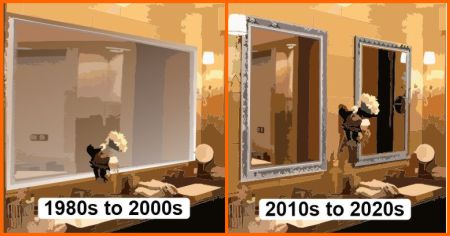
A change in bathroom mirror styles has taken place over the last 20 years. Previously, the fashion was for large, full-width vanity mirrors, sometimes with beveled mirror strips as borders. These now appear dated and have been superseded by elegant “his and hers” custom-framed mirrors (right) that provide a greater opportunity for coordination of the mirrors with the bathroom furniture. So now it can be said that larger is not better.
Tilting bathroom mirrors

Always Consider the Function
Tilting mirrors adjust to the heights of family members. Always place function ahead of aesthetics (unless your name is Oscar Wilde).
Call Artistry in Glass for tilt mirror advice or check these numerous options on Amazon.
Positioning mirrors – a final word
Always keep your eyes wide open and your mind alert for new possibilities. The “rules” in this post are not set in stone but are intended to be broken if necessary.
Sometimes just placing a large mirror against the wall without hangers is the best solution. Always consider the tilt of the mirror to change the angle (what’s your angle man?)
Have confidence in your own taste!
Custom mirrors from Artistry in Glass for residents of Southern Arizona
If you have your favorite frame, bring it to the mirror experts at Artistry in Glass and we will provide an appropriate mirror. Ask us for advice on luxurious beveled mirrors, sophisticated smoked or antique mirrors, or affordable 1/8″ plain mirrors. We size, cut, and install the mirrors into your frames and can also restore damaged frames.
Unique Mirror Resources from Artistry in Glass
Mirror Design & layout
- How are mirrors made?
- What is a beveled mirror?
- What is a two-way mirror?
- Best mirrors for bedrooms
- How to size and position your wall mirror
- How to order custom etched mirrors
- Best places to hang dining room mirrors
- How much do wall mirrors cost?
- Shop the MIRROR Family Package
Mirror Installation & Removal
- How to hang a wall mirror
- How to frame a builder’s grade bathroom mirror
- How to hang a frameless mirror with glue
- Best clips for hanging mirrors
- How to attach a mirror to a closet door
- How to remove a mirror glued to the wall
Mirror Repair & Restoration
- Should I resilver my antique mirror?
- Can I repair scratched mirror silvering?
- What is the best spray paint for mirror silvering?
- How to fix a cracked mirror
- How to repair a broken mirror frame
Artistry in Glass was your source for antique repair in Tucson
Check out this amazing selection of informative articles:-
- Where can I get antiques repaired?
- Are broken antiques worth fixing?
- How to fix a broken picture frame
- How to repair a broken china plate
- How to repair a broken china teapot
- How to fix a broken marble slab
- How to repair a broken china coffee mug
- How to repair a 2000-year-old sculpture
- All about repairing stained-glass lampshades
- How to care for your stained glass skylight
- How to repair Dalle de Verre
- Is stained glass worth repairing?
- To repair or toss out?
- Tucson crystal & china repair a division of Artistry in Glass
- What to do with broken antiques
- Is lead crystal dangerous?
- Repairing an antique Mexican statue
- Repairing religious statues
- The history of Swarovski crystal figurines
- How to find the value of a Swarovski Crystal figurine
- Have Swarovski crystal figurines lost value since 2009?
- How to collect Swarovski annual ornaments
- How to display Swarovski crystal figurines
- How to authenticate a Swarovski crystal figurine
- How to display Swarovski annual ornaments
- How to clean Swarovski crystal figurines
- How to repair a Swarovski crystal mouse
- How to repair a Swarovski annual ornament
- How to repair a Swarovski crystal train set
- Fixing broken wine glass stems
- How to clean cloudy glasses
- Why do wine glasses have stems?
- Swarovski Crystal Figurines
- How to repair a chip in a wine glass
- How to fix a scratched glass tabletop
- How to replace a broken patio tabletop
